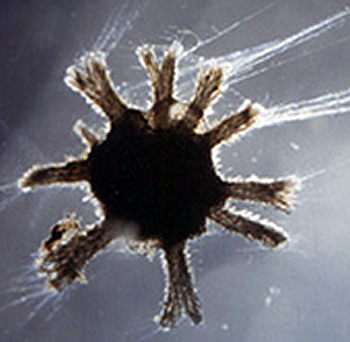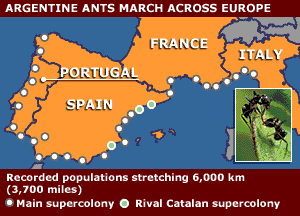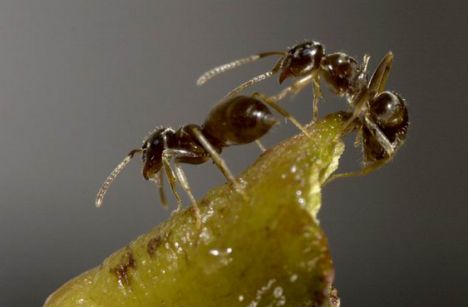Fungus Among Us
Oldest and LargestThe newest computer can merely compound, at speed, the oldest problem in the relations between human beings, - Edward R Murrow There is always a heavy demand for fresh mediocrity. - Paul Gauguin Methuselah Mushroomby Chuck Shepherd Frontiers of Science - A US Forest Service researcher recently announced that her team had discovered the largest living thing ever found, a 24-centuries-old fungus. This fungus covers 2,200 acres in the Blue Mountains of eastern Oregon. DNA testing confirmed that the underground, string-like structure was all the same organism, making it the oldest, as well as the largest, living thing ever discovered. Source: Funny Times January 2001 "News of the Weird"
If you feel (as I do) that the earth is a living organism, then that puts this fungus in second place. The fungus, however, is quite large - 3.5 miles (5.6 kilometres) across and extending 3 feet into the ground (with some filaments going as deep as 10 feet). It is a member of the Armillaria family commonly called a honey mushroom. Unfortunately, it is killing trees by causing "root rot" (interfering with the trees' ability to uptake nutrients) as it grows. Another fungus in the state of Washington covers 1,500 acres.
"Humongous Fungus" Takes Toll on Fir ForestRoot Rot - The World's Largest Organism Is the Size of 1,600 Football Fieldsby Richard Cockle Prairie City - Question: What does the world's largest living organism do all day? Answer: Pretty much whatever it wants. But very slowly. The US Forest Service has adopted an informal live-and-let-live policy for the enormous tree killer it calls the "humongous fungus." The huge root-rot infestation underlies 2,200 acres east of Prairie City in a remote corner of eastern Oregon's Blue Mountains at an elevation of about 6,500 feet near the Strawberry Mountain and Monument Rock wilderness areas. The Forest Service plans to publish a brochure about the gigantic fungus, Armillaria ostoyae, this summer. "There is no way to eliminate it," said Malheur National Forest ecologist and tree expert Mike Tatum of John Day. Most people walking by would never know the fungus lurks just below the ground's surface, occupying its time in the quiet business of sending out shoestring-like tentacles called rhizomorphs and wrapping them around tree roots. Its sheer mass - it's roughly the size of 1,600 football fields - makes Herman Melville's fictional white whale Moby Dick seem like a tadpole. And it could get bigger. In terms of age, Armillaria is a fungiform Methuselah. Researchers say it may have been 100 years old when Alexander the Great conquered the known world in 330 BC. And some estimates suggest it could be 8,000 years old, said Forest Service researcher Catherine Parks, who has spent 10 years studying it. Parks, a research ecologist with the Pacific Northwest Research Station in La Grande, led the studies in cooperation with Oregon State University. She said age estimates are based on measurements of its rate of growth, but vary significantly because of the likelihood of weather and climate shifts over the millennia. Through DNA fingerprinting and a process called vegetative pairing, Parks' research team determined that Armillaria is a single organism and therefore the biggest living thing on earth. Another Armillaria fungus in a 1,500-acre tract of Ponderosa pine near Mount Adams in Washington state previously had been thought to hold the unofficial title. Researchers took samples from different sites and grew them together on petri dishes. Instead of forming barrier lines, samples grew together, establishing that they were of the same organism, Parks said. When word got around, a pesticide applicator in Georgia telephoned Parks. "He said, 'I read about your problem, and I can kill it,'" she recalls. Parks politely declined. Armillaria is just too big, and virtually all of it is underground, she said. The fungus can be found worldwide, but prefers dense, closed-canopy forests - the kind that allow hikers to see little of the sky as they tramp along, Tatum said. The only obvious signs of its presence are the gaps created when it kills trees. Such openings aren't necessarily bad because they allow fungus-resistant tree species and undergrowth to get a foothold, Parks said. And when a tree dies, it recycles its nutrients into the soil for trees that come after it, she said. Douglas fir and white fir are particularly vulnerable to the fungus here in the Northwest, while Western larch and Ponderosa pine tend to be more resistant, she said. Armillaria spreads by extending its rhizomorphs through the upper soil and among tree roots, Tatum said. The rhizomorphs can reach out 10 feet and penetrate roots by a combination of enzyme action and physical pressure. Infected trees can be identified by cutting into the bark above the root. White filaments called mycelia that sap water and carbohydrates from the tree to feed the fungus are always present in infected trees. "It looks like latex paint," Parks said of the telltale mycelia. "You can peel it off in a layer." From an aircraft, biologists see "little rings of dead trees" when Armillaria is present in a forest, Parks said. The fungus never kills all the trees, but the rings sometimes coalesce into larger patterns of mortality, she said. Whether that's good or bad depends on your point of view, but the fungus is part of the ecosystem, Parks said. "If your land management objective is to grow trees, it is definitely counter to that," she noted. Tatum says a big, hot wildfire might someday cut the humongous fungus down to size. A 5,000-acre conflagration sideswiped it about 4 years ago, and the flames killed host trees and energised soil organisms hostile to the fungus, he said. On the other hand, it might get a lot bigger if nature fires no more broadsides its way, he said. "It will always be out there," Tatum said. Richard Cockle rcockle@oregonwireless.net Source: oregonlive.com 10 June 2007 See Also:
Giant Protozoa
Calcarina, a foram The biggest single-celled protozoa are ocean dwelling creatures called foraminifera or forams for short. While many species of foraminifera don’t grow over a single millimeter in diameter, the largest forams can reach sizes of 5 to 6 centimeters (a little over 2 inches) in diameter. (Fossils of ancient forams have reached up to 15 centimeters!) A single cell get that huge thanks in part to shells. Forams build shells called tests that can support the large size that some of these creatures reach. The tests are commonly divided into chambers that are added as the protozoan grows. The foram cell typically occupies all but the one or two most recently added chambers, the last of which opens out to the seawater. In their simplest forms, tests may be little more than hollow balls or open tubes. But some foram tests can take very complex shapes. Depending on the species, foram tests may be made of sand grains, organic compounds, and other particles cemented together, or they may be made of crystalline calcite, the same mineral that sea shells are made of. The chambers in larger foram tests often serve as a home for algae and cyanobacteria as well. The forams "farm" these microbes for the compounds they produce as they turn sunlight into energy. Forams also eat bacteria, diatoms, other protozoa and even small animals such as copepods. In turn, forams are an important food source for snails, sand dollars, fish and other creatures. Forams move about and catch their food using hairlike extensions of their cell fluid called reticulopodia that poke out of their tests (white "threads" in the photo above). These extensions are like the pseudopods, or oozing "false feet" that amœbas form, only they’re much thinner and more numerous. Source: microbe.org photo courtesy of John J Lee
Ant Supercolony Dominates Europe
A species of Argentine ant introduced into Europe about 80 years ago has developed the largest supercolony ever recorded. It stretches 6,000 kilometres - from northern Italy, through the south of France to the Atlantic coast of Spain - with billions of related ants occupying millions of nests. While ants from rival nests normally fight each other to the death, ants from the supercolony have the ability to recognise each other and co-operate - even if they come from nests at opposite ends of the colony's range. The Argentine species (Linepithema humile) probably came into Europe on imported plants, pushing back the 20 or so indigenous species of European ant. Scientists are not entirely sure why the supercolony has emerged. They think the initial success of the alien invaders would have led to high nest densities, which in turn would have favoured co-operative behaviour over aggression. And evolution would then have reinforced this superiority because nests devoid of internal strife would have had time and resources to fight off their enemies. "It is interesting to see that introduction in a new habitat can change social organisation," said Professor Laurent Keller, of the University of Lausanne, Switzerland, and one of the scientists to have identified the supercolony. "In this case, this leads to the greatest co-operative unit ever discovered." But Professor Keller and colleagues say the supercolony may be doomed. Sooner or later, rivalries will emerge as genetically distinct groups of ants turn against each other. The supercolony itself also has a rival - a second, smaller supergroup of Argentine ants holds sway in the Catalan region of Spain. These creatures are more than happy to make war. The ants would have come into Europe on imported plants. The research, by Swiss, French and Danish scientists, is published in The Proceedings of the National Academy of Sciences. Professor Jurgen Heinze, an expert on ants at Erlangen University, Germany, is impressed with the work. He says there must be some important genetic similarities running through the colony. "An ant has to decide when encountering another individual whether this individual belongs to its colony or not. The recognition cues are odours on the surface of the ant and these odours are in part genetically based. Genetic variation leads to variation in the recognition cues and if there is a loss of genetic variation, the ants all smell alike and they can no longer distinguish between alien ants and nest mates." Source: news.bbc.co.uk Tuesday 16 April 2002
Global Swarming: The Super Ants Ready to Invade Your Garden - 100 Million at a Time
Crawling menace: Experts believe it is only a matter of time before Lasius neglectus ants arrive in Britain by Fiona Macrae It lives in super colonies of more than 100million and thrives in the cold. Its name is Lasius neglectus - and it is heading for Britain. Harmless to humans and not very different to look at than our own garden ant, Lasius is nevertheless causing researchers great concern. So massive are its colonies, covering acres of ground, that it can drive out native insects and other species simply by out-competing them for food. Apparently preferring urban parks and gardens to rural areas, it also invades houses, attracted to the magnetic fields created by plug sockets and often causing power failures by eating through wiring. Thought to have originated in Turkey, by 2000 it had taken up residence in 30 parts of Europe. Now the flightless creature's huge colonies can be found in 108 locations in 15 countries, from Belgium to Uzbekistan. Experts believe it is only a matter of time before the ant marches into Britain - that is, if it is not already here. Researcher Dr Sylvia Cremer said: "We assume they are going to spread even more or that they have spread already. They look like normal garden ants but there are masses of them." Lasius neglectus colonies are made up of as many as 1,000 nests. Individual ants can move from nest to nest over areas that can stretch for miles, meaning the colony is essentially a single formidable unit. Professor Jacobus Boomsma, one of those who discovered the species, said: "When I saw this ant for the first time, I simply could not believe there could be so many garden ants in the same lawn." One super colony of Laslus neglectus had 112 million workers and 350,000 queens. Lasius neglectus can thrive in temperatures as low as 5° Centigrade, meaning it is perfectly adapted to the British weather. Writing in the science journal PLoS ONE, the researchers said: "Whereas most other pest ants require warm temperatures, Lasius neglectus can survive winters with extended frost periods, so that further dispersal into temperate climatic zones seems unavoidable. Invasive Lasius neglectus populations are a potential problem of global dimensions and a particular threat for man-made eco-systems in the cold - temperate climate zones that have so far suffered very little from invasive ants." Established colonies are very difficult to eradicate, meaning the quicker they are spotted the better. Source: dailymail.co.uk 3 December 2008 See also:
For more on the unusual: events, abilities, means of self-expression, houses, conditions, people, luck, narrow escapes, resemblances, facts, diversions, heroism and more - click the "Up" button below to
take you to the Index page for this Odds and Oddities section. |
 Animals
Animals Animation
Animation Art of Playing Cards
Art of Playing Cards Drugs
Drugs Education
Education Environment
Environment Flying
Flying History
History Humour
Humour Immigration
Immigration Info/Tech
Info/Tech Intellectual/Entertaining
Intellectual/Entertaining Lifestyles
Lifestyles Men
Men Money/Politics/Law
Money/Politics/Law New Jersey
New Jersey Odds and Oddities
Odds and Oddities Older & Under
Older & Under Photography
Photography Prisons
Prisons Relationships
Relationships Science
Science Social/Cultural
Social/Cultural Terrorism
Terrorism Wellington
Wellington Working
Working Zero Return Investment
Zero Return Investment

